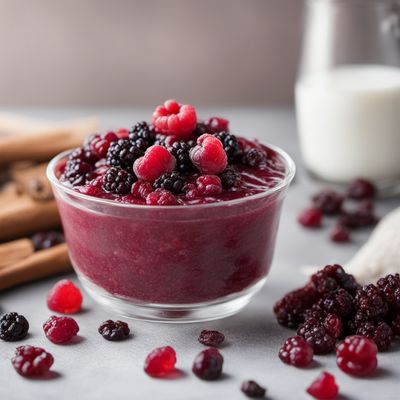
Ingredient
Raisin wine
The Sweet Elixir of the Vine
Raisin wine is made from dried grapes, which are left to ferment and age, resulting in a concentrated and sweet wine. It has a deep amber or golden color, with a syrupy texture that coats the palate. The flavor of raisin wine is intensely sweet, with notes of dried fruits, honey, and caramel. Its aroma is rich and inviting, reminiscent of ripe grapes and sun-drenched vineyards. When used in cooking, raisin wine imparts a delightful sweetness and complexity to dishes, making it a prized ingredient in many cuisines.
Origins and history
The history of raisin wine dates back thousands of years, with evidence of its production found in ancient civilizations such as Egypt and Greece. It was highly valued for its long shelf life and concentrated flavors, making it a popular choice for trade and consumption. Raisin wine has been used in various culinary traditions around the world, from Mediterranean cuisines to Middle Eastern and Asian dishes. Today, it continues to be cherished for its unique taste and versatility in both sweet and savory recipes.
Nutritional information
Raisin wine is not a significant source of nutrients and is primarily consumed for its flavor and culinary applications. It is important to enjoy raisin wine in moderation due to its high sugar content.
Allergens
Raisin wine may contain sulfites, which can cause allergic reactions in some individuals. It is important to read labels and check for any potential allergens before consuming or using raisin wine in recipes.
How to select
When selecting raisin wine, look for high-quality bottles that are well-aged and have a rich, amber color. Opt for wines that have a balanced sweetness and acidity, as this will enhance their versatility in cooking. Consider the specific recipe and desired flavor profile when choosing a raisin wine, as different varieties can vary in sweetness and intensity.
Storage recommendations
To preserve the freshness and quality of raisin wine, store it in a cool, dark place away from direct sunlight. Keep the bottle tightly sealed to prevent oxidation and spoilage. Once opened, refrigerate the wine and consume it within a few weeks to maintain its optimal flavor.
How to produce
Producing raisin wine at home requires specialized equipment and knowledge of winemaking techniques. It is recommended to leave the production of raisin wine to professional wineries and focus on its culinary applications instead.
Preparation tips
When using raisin wine in recipes, it is important to consider its sweetness and intensity. Use it sparingly to avoid overpowering the dish, and adjust the sweetness of the recipe accordingly. Raisin wine is commonly used in marinades, sauces, and glazes for meats, adding a touch of sweetness and complexity. It is also a key ingredient in desserts such as poached fruits, fruit compotes, and rich sauces for ice cream or cakes.
Culinary uses
Raisin wine is widely used in both sweet and savory culinary applications. It is often used to enhance the flavors of meats, such as in a red wine reduction for beef or a glaze for roasted poultry. In desserts, raisin wine is a popular choice for poaching fruits, making fruit compotes, or creating decadent sauces for ice cream or cakes. It can also be enjoyed on its own as a dessert wine, paired with cheese or chocolate.
Availability
Raisin wine is commonly available in regions with a strong winemaking tradition, such as Europe, the Mediterranean, and the Middle East. It can also be found in specialty wine shops and online retailers that offer a wide selection of wines from around the world.
More ingredients from this category
Recipes using Raisin wine » Browse all

Bisciola - Italian Sweet Bread with Dried Fruits and Nuts
Fruity Nut Delight: A Sweet Italian Bread to Savor

Krentjebrij - Dutch Spiced Berry Porridge
Warm and Spiced Berry Delight: Krentjebrij

Spongata - Italian Spiced Nut and Fruit Tart
Aromatic Delight: Indulge in the Flavors of Spongata

Jamaican Rum Cake Recipe
Caribbean Delight: Jamaican Rum Cake

Rocciata - Italian Sweet Pastry
Delizioso Dolce: A Sweet Journey with Rocciata

Aromatic Beef Pilaf with Dried Fruits
Sultan's Delight: A Flavorful Journey through Azerbaijani Cuisine

Lady Baltimore Dream Cake
Heavenly Delights: Lady Baltimore Dream Cake

Krentenbollen - Dutch Raisin Buns
Golden Raisin Delights: Traditional Dutch Krentenbollen Recipe

Bostrengo - Italian Sweet Polenta Cake
Heavenly Delights: Indulge in the Irresistible Italian Sweet Polenta Cake

Sfogi in Saor
Venetian Delight: Sfogi in Saor

Certosino - Italian Christmas Fruitcake
Festive Delight: A Decadent Italian Christmas Fruitcake

Baked Apples in a Blanket
Crispy Cinnamon Delight: Baked Apples in Puff Pastry

